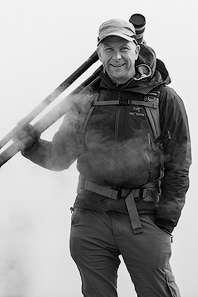High dynamic range light continues to be a challenge for outdoor photographers. Another term for dynamic range is contrast. As long as the contrast of a scene, from darkest shadow to brightest highlight, does not exceed the camera’s ability to record dynamic range it is possible to record detail throughout a scene in a single exposure. In nature, especially around sunset and sunrise when the sky is bright and the landscape is much darker, the contrast often exceeds the camera’s dynamic range ability. Going all the way back to it’s beginning, more than 150 years ago, photographers have looked for ways to deal with high dynamic range light. There are many in-camera techniques for this, such as using a graduated neutral density filter to hold back light in bright areas or using some sort of artificial lighting to illuminate dark areas. In the current era, digital images and imaging software have made it possible to combine multiple exposures that contain image detail for all light values in a high dynamic range situation. This can be done with automated HDR software or by using masking techniques in Photoshop to “hand blend” multiple exposure values into a single extended dynamic range scene.

Whatever technique is being used to blend the exposures, it is necessary to first capture or “bracket” a series of exposures that encompasses the entire dynamic range. Knowing when and how to bracket exposures so that you have collected enough detail across the entire light range can be confusing. My goal is to take only the exposures I need, no more and no less. Most non point and shoot cameras feature an Auto Exposure Bracketing (AEB) feature but I find that it often doesn’t succeed in capturing what I need. Sometimes the number of exposures I have set is too many and some times it is too few. Even if I guess right and choose the correct number of exposures, the camera often misreads the scene and doesn’t center the exposure series properly, missing important details either at the shadow or highlight end of the range.

I have the most success when I manually bracket exposures but this requires establishing a well practiced approach to be able to do it quickly and consistently. Help with manually bracketing exposures is a common request during workshops. In the video above I explain how I evaluate a histogram to determine when bracketing is necessary and I also outline two different manual bracketing methods I use to make sure that I have successfully recorded the entire dynamic range.
I’m currently working on a complete update to my video tutorial series called Developing for Extended Dynamic Range and this is one of the chapters. Production on the updated series will be completed and the new videos should be available by the end of January, 2015. I will be sending out an email notice to people who own the original series when it is available. I will also be teaching a weekend class on exposure blending and developing for extended dynamic range in Bend, Oregon in May.

Sean is an outdoor photographer, digital image developing enthusiast and photography educator based in Ashland, Oregon, where he resides with his wife and two sons. His previous career as a science teacher makes photography education a good fit. Sean teams up with fellow Photo Cascadia members leading workshops. He also teaches digital image developing classes, lectures and offers a series of Photoshop video tutorials.
More posts by Sean Visit Sean’s Image Gallery Visit Sean’s Website

Recent Comments